Masahiro Ikeda
Why High-rank Neural Networks Generalize?: An Algebraic Framework with RKHSs
Sep 26, 2025Abstract:We derive a new Rademacher complexity bound for deep neural networks using Koopman operators, group representations, and reproducing kernel Hilbert spaces (RKHSs). The proposed bound describes why the models with high-rank weight matrices generalize well. Although there are existing bounds that attempt to describe this phenomenon, these existing bounds can be applied to limited types of models. We introduce an algebraic representation of neural networks and a kernel function to construct an RKHS to derive a bound for a wider range of realistic models. This work paves the way for the Koopman-based theory for Rademacher complexity bounds to be valid for more practical situations.
Generalization Through Growth: Hidden Dynamics Controls Depth Dependence
May 21, 2025Abstract:Recent theory has reduced the depth dependence of generalization bounds from exponential to polynomial and even depth-independent rates, yet these results remain tied to specific architectures and Euclidean inputs. We present a unified framework for arbitrary \blue{pseudo-metric} spaces in which a depth-\(k\) network is the composition of continuous hidden maps \(f:\mathcal{X}\to \mathcal{X}\) and an output map \(h:\mathcal{X}\to \mathbb{R}\). The resulting bound $O(\sqrt{(\alpha + \log \beta(k))/n})$ isolates the sole depth contribution in \(\beta(k)\), the word-ball growth of the semigroup generated by the hidden layers. By Gromov's theorem polynomial (resp. exponential) growth corresponds to virtually nilpotent (resp. expanding) dynamics, revealing a geometric dichotomy behind existing $O(\sqrt{k})$ (sublinear depth) and $\tilde{O}(1)$ (depth-independent) rates. We further provide covering-number estimates showing that expanding dynamics yield an exponential parameter saving via compositional expressivity. Our results decouple specification from implementation, offering architecture-agnostic and dynamical-systems-aware guarantees applicable to modern deep-learning paradigms such as test-time inference and diffusion models.
Spectral Truncation Kernels: Noncommutativity in $C^*$-algebraic Kernel Machines
May 28, 2024


Abstract:In this paper, we propose a new class of positive definite kernels based on the spectral truncation, which has been discussed in the fields of noncommutative geometry and $C^*$-algebra. We focus on kernels whose inputs and outputs are functions and generalize existing kernels, such as polynomial, product, and separable kernels, by introducing a truncation parameter $n$ that describes the noncommutativity of the products appearing in the kernels. When $n$ goes to infinity, the proposed kernels tend to the existing commutative kernels. If $n$ is finite, they exhibit different behavior, and the noncommutativity induces interactions along the data function domain. We show that the truncation parameter $n$ is a governing factor leading to performance enhancement: by setting an appropriate $n$, we can balance the representation power and the complexity of the representation space. The flexibility of the proposed class of kernels allows us to go beyond previous commutative kernels.
Constructive Universal Approximation Theorems for Deep Joint-Equivariant Networks by Schur's Lemma
May 22, 2024

Abstract:We present a unified constructive universal approximation theorem covering a wide range of learning machines including both shallow and deep neural networks based on the group representation theory. Constructive here means that the distribution of parameters is given in a closed-form expression (called the ridgelet transform). Contrary to the case of shallow models, expressive power analysis of deep models has been conducted in a case-by-case manner. Recently, Sonoda et al. (2023a,b) developed a systematic method to show a constructive approximation theorem from scalar-valued joint-group-invariant feature maps, covering a formal deep network. However, each hidden layer was formalized as an abstract group action, so it was not possible to cover real deep networks defined by composites of nonlinear activation function. In this study, we extend the method for vector-valued joint-group-equivariant feature maps, so to cover such real networks.
Koopman operators with intrinsic observables in rigged reproducing kernel Hilbert spaces
Mar 14, 2024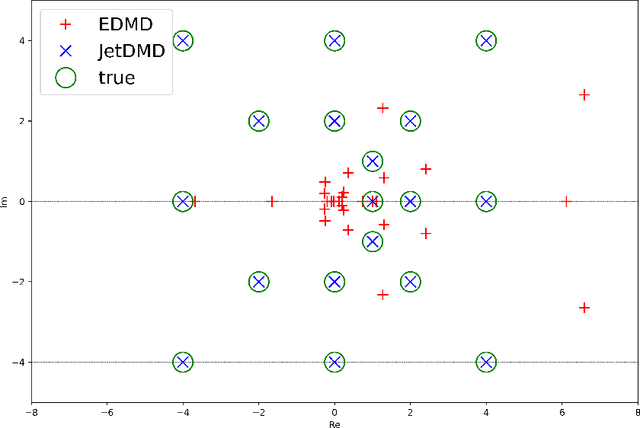

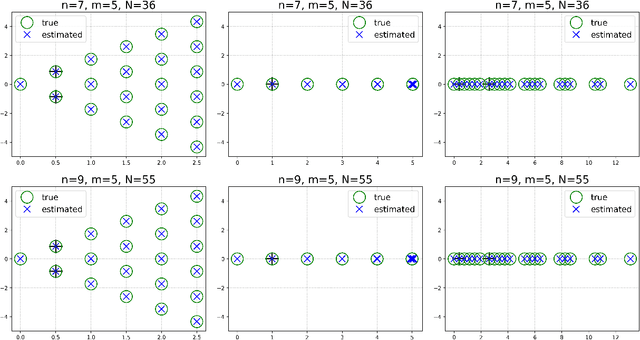

Abstract:This paper presents a novel approach for estimating the Koopman operator defined on a reproducing kernel Hilbert space (RKHS) and its spectra. We propose an estimation method, what we call Jet Dynamic Mode Decomposition (JetDMD), leveraging the intrinsic structure of RKHS and the geometric notion known as jets to enhance the estimation of the Koopman operator. This method refines the traditional Extended Dynamic Mode Decomposition (EDMD) in accuracy, especially in the numerical estimation of eigenvalues. This paper proves JetDMD's superiority through explicit error bounds and convergence rate for special positive definite kernels, offering a solid theoretical foundation for its performance. We also delve into the spectral analysis of the Koopman operator, proposing the notion of extended Koopman operator within a framework of rigged Hilbert space. This notion leads to a deeper understanding of estimated Koopman eigenfunctions and capturing them outside the original function space. Through the theory of rigged Hilbert space, our study provides a principled methodology to analyze the estimated spectrum and eigenfunctions of Koopman operators, and enables eigendecomposition within a rigged RKHS. We also propose a new effective method for reconstructing the dynamical system from temporally-sampled trajectory data of the dynamical system with solid theoretical guarantee. We conduct several numerical simulations using the van der Pol oscillator, the Duffing oscillator, the H\'enon map, and the Lorenz attractor, and illustrate the performance of JetDMD with clear numerical computations of eigenvalues and accurate predictions of the dynamical systems.
A unified Fourier slice method to derive ridgelet transform for a variety of depth-2 neural networks
Feb 25, 2024Abstract:To investigate neural network parameters, it is easier to study the distribution of parameters than to study the parameters in each neuron. The ridgelet transform is a pseudo-inverse operator that maps a given function $f$ to the parameter distribution $\gamma$ so that a network $\mathtt{NN}[\gamma]$ reproduces $f$, i.e. $\mathtt{NN}[\gamma]=f$. For depth-2 fully-connected networks on a Euclidean space, the ridgelet transform has been discovered up to the closed-form expression, thus we could describe how the parameters are distributed. However, for a variety of modern neural network architectures, the closed-form expression has not been known. In this paper, we explain a systematic method using Fourier expressions to derive ridgelet transforms for a variety of modern networks such as networks on finite fields $\mathbb{F}_p$, group convolutional networks on abstract Hilbert space $\mathcal{H}$, fully-connected networks on noncompact symmetric spaces $G/K$, and pooling layers, or the $d$-plane ridgelet transform.
$C^*$-Algebraic Machine Learning: Moving in a New Direction
Feb 04, 2024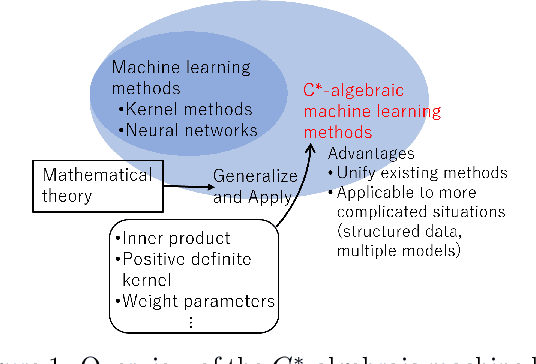
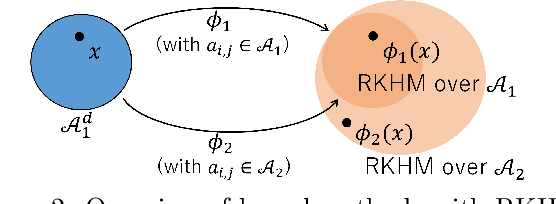
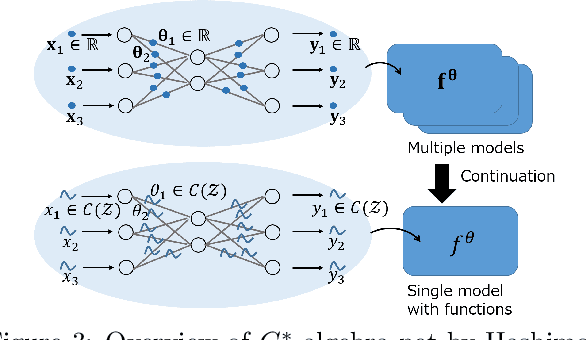
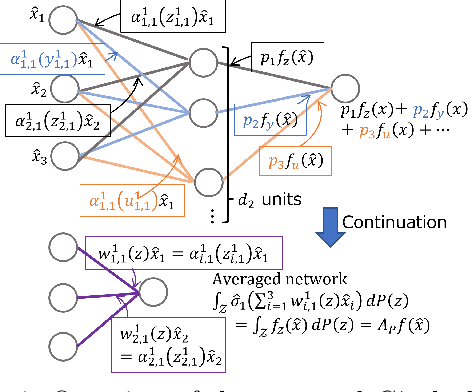
Abstract:Machine learning has a long collaborative tradition with several fields of mathematics, such as statistics, probability and linear algebra. We propose a new direction for machine learning research: $C^*$-algebraic ML $-$ a cross-fertilization between $C^*$-algebra and machine learning. The mathematical concept of $C^*$-algebra is a natural generalization of the space of complex numbers. It enables us to unify existing learning strategies, and construct a new framework for more diverse and information-rich data models. We explain why and how to use $C^*$-algebras in machine learning, and provide technical considerations that go into the design of $C^*$-algebraic learning models in the contexts of kernel methods and neural networks. Furthermore, we discuss open questions and challenges in $C^*$-algebraic ML and give our thoughts for future development and applications.
Joint Group Invariant Functions on Data-Parameter Domain Induce Universal Neural Networks
Oct 05, 2023Abstract:The symmetry and geometry of input data are considered to be encoded in the internal data representation inside the neural network, but the specific encoding rule has been less investigated. By focusing on a joint group invariant function on the data-parameter domain, we present a systematic rule to find a dual group action on the parameter domain from a group action on the data domain. Further, we introduce generalized neural networks induced from the joint invariant functions, and present a new group theoretic proof of their universality theorems by using Schur's lemma. Since traditional universality theorems were demonstrated based on functional analytical methods, this study sheds light on the group theoretic aspect of the approximation theory, connecting geometric deep learning to abstract harmonic analysis.
Deep Ridgelet Transform: Voice with Koopman Operator Proves Universality of Formal Deep Networks
Oct 05, 2023
Abstract:We identify hidden layers inside a DNN with group actions on the data space, and formulate the DNN as a dual voice transform with respect to Koopman operator, a linear representation of the group action. Based on the group theoretic arguments, particularly by using Schur's lemma, we show a simple proof of the universality of those DNNs.
Deep Learning with Kernels through RKHM and the Perron-Frobenius Operator
May 23, 2023Abstract:Reproducing kernel Hilbert $C^*$-module (RKHM) is a generalization of reproducing kernel Hilbert space (RKHS) by means of $C^*$-algebra, and the Perron-Frobenius operator is a linear operator related to the composition of functions. Combining these two concepts, we present deep RKHM, a deep learning framework for kernel methods. We derive a new Rademacher generalization bound in this setting and provide a theoretical interpretation of benign overfitting by means of Perron-Frobenius operators. By virtue of $C^*$-algebra, the dependency of the bound on output dimension is milder than existing bounds. We show that $C^*$-algebra is a suitable tool for deep learning with kernels, enabling us to take advantage of the product structure of operators and to provide a clear connection with convolutional neural networks. Our theoretical analysis provides a new lens through which one can design and analyze deep kernel methods.
 Add to Chrome
Add to Chrome Add to Firefox
Add to Firefox Add to Edge
Add to Edge